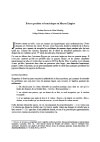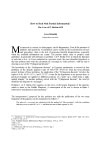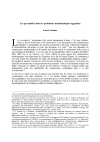Mathématiques
« Fausse position et heuristique au Moyen Empire »
ENiM 8, 2015, p. 113-132.
 Les Anciens Égyptiens ont développé des procédés originaux et simples pour résoudre de nombreux problèmes mathématiques. Mais pour le comprendre, il faut se détacher de l’approche algébrique moderne. Nous rappelons d’abord qu’ils connaissaient la méthode de la fausse position. Cela ressort non seulement de quatre problèmes du papyrus Rhind, mais aussi de deux problèmes plus anciens contenus dans le papyrus 6619 de Berlin (nous proposons pour l’un d’eux un nouvel énoncé). Et nous montrons ensuite, à travers quatre problèmes – deux du papyrus de Moscou et deux du papyrus Rhind – que ce procédé s’inscrivait dans un processus heuristique beaucoup plus large.
Les Anciens Égyptiens ont développé des procédés originaux et simples pour résoudre de nombreux problèmes mathématiques. Mais pour le comprendre, il faut se détacher de l’approche algébrique moderne. Nous rappelons d’abord qu’ils connaissaient la méthode de la fausse position. Cela ressort non seulement de quatre problèmes du papyrus Rhind, mais aussi de deux problèmes plus anciens contenus dans le papyrus 6619 de Berlin (nous proposons pour l’un d’eux un nouvel énoncé). Et nous montrons ensuite, à travers quatre problèmes – deux du papyrus de Moscou et deux du papyrus Rhind – que ce procédé s’inscrivait dans un processus heuristique beaucoup plus large.
 The ancient Egyptians developed original and simple methods to solve many mathematical problems. But to understand this, one must be careful not to project our own algebra system backwards in time. First, we point out that they knew the false position method, as is demonstrated not only by four problems in the Rhind papyrus, but also by two more ancient problems from papyrus Berlin 6619 (we propose a new wording for one of them). Second, we highlight by means of four problems – two from the Moscow papyrus and two from the Rhind papyrus – that this method was part of a much larger heuristic process.
The ancient Egyptians developed original and simple methods to solve many mathematical problems. But to understand this, one must be careful not to project our own algebra system backwards in time. First, we point out that they knew the false position method, as is demonstrated not only by four problems in the Rhind papyrus, but also by two more ancient problems from papyrus Berlin 6619 (we propose a new wording for one of them). Second, we highlight by means of four problems – two from the Moscow papyrus and two from the Rhind papyrus – that this method was part of a much larger heuristic process.
 Consulter cet article (45765) -
Consulter cet article (45765) -  Télécharger cet article au format pdf (21196)
Télécharger cet article au format pdf (21196)
« How to Deal with Partial Information? The Case of P. Berlin 6619 »
ENiM 9, 2016, p. 5-14.
 Dans le problème 1 du P. Berlin 6619, la dernière partie de chaque ligne est perdue. Dans cet article, j’indique les raisons pour lesquelles l’interprétation de la manière de procéder ne peut se fonder uniquement sur des raisonnements mathématiques, mais aussi sur l’expérimentation concrète d’hypothèses de reconstruction des phrases manquantes. L’analyse du texte du problème indique que les côtés d’un rectangle sont calculés avec l’objectif de montrer un cas du « théorème de Pythagore ». Une autre hypothèse, avancée au début du siècle dernier, est infirmée.
Dans le problème 1 du P. Berlin 6619, la dernière partie de chaque ligne est perdue. Dans cet article, j’indique les raisons pour lesquelles l’interprétation de la manière de procéder ne peut se fonder uniquement sur des raisonnements mathématiques, mais aussi sur l’expérimentation concrète d’hypothèses de reconstruction des phrases manquantes. L’analyse du texte du problème indique que les côtés d’un rectangle sont calculés avec l’objectif de montrer un cas du « théorème de Pythagore ». Une autre hypothèse, avancée au début du siècle dernier, est infirmée.
 In problem 1 of P. Berlin 6619 the final part of each line is lost. In this paper I indicate the reasons why the interpretation of the procedure cannot be based only on mathematical arguments, but also on concrete experimentations of hypotheses of reconstruction of the sentences and restoration of the missing parts. The analysis of the problem text indicates that the sides of a rectangle are calculated with the aim of showing a case of the “Pythagorean theorem”. An alternative hypothesis, advanced at the beginning of last century, is unsupported and unsuitable.
In problem 1 of P. Berlin 6619 the final part of each line is lost. In this paper I indicate the reasons why the interpretation of the procedure cannot be based only on mathematical arguments, but also on concrete experimentations of hypotheses of reconstruction of the sentences and restoration of the missing parts. The analysis of the problem text indicates that the sides of a rectangle are calculated with the aim of showing a case of the “Pythagorean theorem”. An alternative hypothesis, advanced at the beginning of last century, is unsupported and unsuitable.
 Consulter cet article (40666) -
Consulter cet article (40666) -  Télécharger cet article au format pdf (21379)
Télécharger cet article au format pdf (21379)
« Les pyramides dans les problèmes mathĂ©matiques Ă©gyptiens »
ENiM 12, 2019, p. 233-246.
 Le papyrus Rhind place les pyramides au centre de quelques problèmes en lien avec des calculs de seqed et de hauteur. Deux autres énoncés, les problèmes pRhind no 60 et pMoscou no 14, ont été maintes fois mis en parallèle avec ces derniers et commentés en raison des difficultés d’interprétation qu’ils suscitent. La terminologie employée, le contexte des exercices, mais aussi l’état de l’archéologie peuvent permettre d’identifier les constructions décrites. L’architecture autorise également quelques comparaisons significatives qui amènent à nous interroger sur l’une des sources d’inspiration des papyri mathématiques du Moyen Empire.
Le papyrus Rhind place les pyramides au centre de quelques problèmes en lien avec des calculs de seqed et de hauteur. Deux autres énoncés, les problèmes pRhind no 60 et pMoscou no 14, ont été maintes fois mis en parallèle avec ces derniers et commentés en raison des difficultés d’interprétation qu’ils suscitent. La terminologie employée, le contexte des exercices, mais aussi l’état de l’archéologie peuvent permettre d’identifier les constructions décrites. L’architecture autorise également quelques comparaisons significatives qui amènent à nous interroger sur l’une des sources d’inspiration des papyri mathématiques du Moyen Empire.
 The Rhind mathematical papyrus incorporates a small group of problems focusing on pyramids and demonstrating how to calculate their seked side slopes and heights. Two other problems, pRhind 60 and pMoscow 14, have been discussed extensively in conjunction with the former problems due to the interpretive challenges they pose. The terminology they use and the context of the exercises mean that archaeology and philology can potentially provide information aiding understanding of the buildings described. Architecture uncovered in excavations may represent structures that inspired the problems outlined in the Middle Kingdom mathematical papyri, and the different classes of evidence are compared here.
The Rhind mathematical papyrus incorporates a small group of problems focusing on pyramids and demonstrating how to calculate their seked side slopes and heights. Two other problems, pRhind 60 and pMoscow 14, have been discussed extensively in conjunction with the former problems due to the interpretive challenges they pose. The terminology they use and the context of the exercises mean that archaeology and philology can potentially provide information aiding understanding of the buildings described. Architecture uncovered in excavations may represent structures that inspired the problems outlined in the Middle Kingdom mathematical papyri, and the different classes of evidence are compared here.
 Consulter cet article (44409) -
Consulter cet article (44409) -  Télécharger cet article au format pdf (21787)
Télécharger cet article au format pdf (21787)
ENiM 18 - 2025
5 article(s) - 2 avril 2025.
ENiM 1 à 18 (2008-2025) : 224 articles
4 128 496 téléchargements
8 501 268 consulations.
Index des auteurs

Mots clés

Derniers articles : 
Robert Steven Bianchi
Duplication and Continuity
(ENiM 18, p. 13-36 — 11 mars 2025) 
Frédéric Mougenot
Rénénoutet à la porte de la maison
(ENiM 18, p. 1-12 — 29 janvier 2025) 
CENiM - Mise en ligne des volumes Ă©puisĂ©s : 
 Anne-Sophie von BOMHARD DĂ©cans Ă©gyptiens, CENiM 23, Montpellier, 2020 — (2020)
Anne-Sophie von BOMHARD DĂ©cans Ă©gyptiens, CENiM 23, Montpellier, 2020 — (2020) 
 Jean-Claude Grenier L'Osiris ANTINOOS, CENiM 1, Montpellier, 2008 — (26 dĂ©cembre 2008)
Jean-Claude Grenier L'Osiris ANTINOOS, CENiM 1, Montpellier, 2008 — (26 dĂ©cembre 2008) 
TDENiM - Mise en ligne des volumes Ă©puisĂ©s : 
 Twitter
Twitter 3655750 visites - 2354 visite(s) aujourd’hui - 82 connecté(s)
© ENiM - Une revue d’égyptologie sur internet
Équipe Égypte Nilotique et Méditerranéenne - UMR 5140 - « Archéologie des Sociétés Méditerranéennes » (Cnrs) - Université Paul Valéry - Montpellier III
























 Contact
Contact
 Abonnez-vous !
Abonnez-vous ! Équipe Égypte Nilotique et Méditerranéenne
Équipe Égypte Nilotique et Méditerranéenne UMR 5140 « Archéologie des Sociétés Méditerranéennes » (Cnrs)
UMR 5140 « Archéologie des Sociétés Méditerranéennes » (Cnrs) Université Paul Valéry - Montpellier III
Université Paul Valéry - Montpellier III